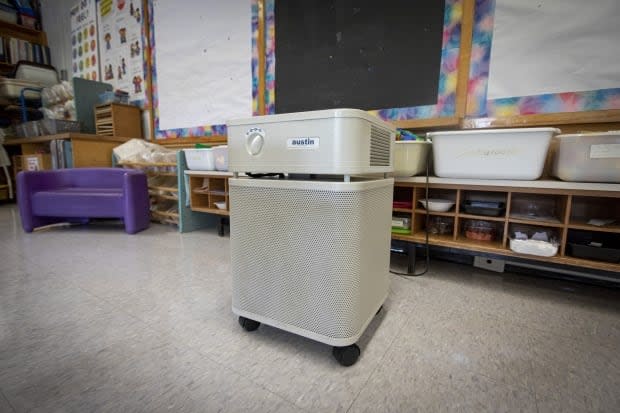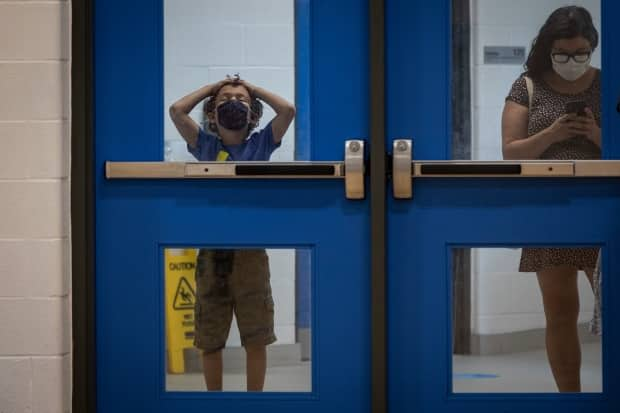What school will look like this fall as Canada struggles to bring COVID-19 under control

It's the start of a third pandemic-disrupted school year, but what Canadian students will face during this fourth wave of COVID-19 will look strikingly different depending on where they live.
While some are disheartened at the easing of safety measures — "It feels as if we're kind of waltzing back to school," said public education advocate Annie Kidder of People for Education — others are more optimistic, given our vaccination rates and experiences drawn from last year.
"We can't just look at case numbers.... We also have to look at what our hospitalization rates are, ICU rates and death rates — and those numbers have thankfully remained much lower as a proportion to the total cases," said Dr. Jacqueline Wong, a pediatric infectious disease specialist at McMaster Children's Hospital in Hamilton.
Here's a quick comparison of back-to-school plans across the country.
North
Yukon schools aim to be at "near normal" operations with some health and safety measures remaining, including mandatory masking on buses and in indoor school common areas (they can be taken off in class). Physical distancing is still encouraged. Field trips that follow public health guidelines are permitted, with outdoor education and "on the land" programming encouraged.
Schools in the Northwest Territories will similarly have mandatory masking on buses and indoor common areas in schools, but they will ease some measures, such as physical distancing in classrooms for Grade 7 and up (but It's still recommended for K-6). Visitors will be limited in schools. Still on hold: indoor classes for drama, singing, music, band; assemblies, high-contact sports and tournaments. Remote learning is available for students with medical concerns.
The Nunavut plan includes daily symptom screening and detailed isolation plans in case of exposure. Masking is at the discretion of public health officials depending on COVID-19 in the community, but it is mandatory for essential visitors not fully vaccinated (no non-essential visitors are permitted). No school assemblies or concerts will be held, but enhanced cleaning, disinfection and physical-distancing requirements are in place for limited gatherings, such as sessions with elders. Schools must prepare for a shift to emergency remote instruction, if needed.
British Columbia and Alberta
British Columbia's measures include daily COVID-19 screening, mandatory masks indoors and on buses for all staff and students in Grade 4 and up (encouraged for Grade 3 and under) and some ventilation upgrades. Music classes resume, but with masks for singing. School meal programs, assemblies and extracurricular activities are back, but with no inter-school competitions or tournaments. Regional public health units may also introduce additional measures for individual schools or districts, depending on community transmission.
WATCH | Public education advocate blasts weakened measures, changing policies:
Alberta has vowed to get "back to normal," with extracurriculars, trips, music classes, meal programs, assemblies, visitors and work placements all returning. Masks will still be required on buses until the end of September. Remaining measures will include daily screening, isolation requirements for students symptomatic or positive for COVID-19 and encouraging 'best practices" for reducing respiratory illnesses.
School districts can add measures and some have, for instance, by continuing masking and cohorting, including Edmonton Public Schools, Edmonton Catholic, Calgary Board of Education and Calgary Catholic School District. CBE has also reopened registration for its online learning option.
Saskatchewan and Manitoba
Saskatchewan is also aiming for a pre-pandemic return. Beyond enhanced cleaning and disinfection, there is no masking requirement, physical distancing or other restrictions seen last year. School officials will collaborate with public health for contact tracing and isolation as needed. Divisions may enact additional policies as needed or directed by local medical officers of health. School boards in Regina, Saskatoon and other regions have re-enacted mask mandates.
Manitoba has mandated masks inside schools and buses, as well as full vaccination for school staff (or frequent COVID-19 testing). Requirements also include daily screening and cohorts for K-6. Remote instruction should be prepared in case it's needed by symptomatic students or if an entire school must shift to remote — a critical status option in the colour-coded provincial plan.

Ontario and Quebec
Ontario has mandated masking from grades 1 to 12 inside schools and on buses, daily screening, cohorts indoors and physical distancing for elementary schools, as well as a vaccination disclosure policy for all school staff. Some ventilation improvements are underway. Assemblies can be held as per public health guidelines; singing and wind instruments are permitted with distancing and ventilation. Field trips, extracurriculars and visitors can return, as will the use of cafeterias and libraries.
Remote learning must be offered by every school board, and officials must plan for pivoting to remote instruction if needed. School boards can also enact stricter measures deemed necessary.
WATCH | How measures from last school year can protect students for this one:
Quebec students must don masks on buses and indoors apart from classrooms. However, in nine regions representing most of the province — including in Montreal and Laval — masks must be worn indoors at all times. Extracurricular activities are back, though proof of vaccination is needed for sports indoors or with frequent, prolonged contact outdoors. Cleaning and disinfecting measures resume, while installation of classroom CO2 detectors to monitor air quality is ongoing.

Atlantic Canada
New Brunswick has mandated masks in all indoor common areas and on buses, as well as required vaccination for all school staff (or regular testing). Field trips, music classes, meal programs and extracurricular activities return, as well as use of cafeterias, limited visitors and community use of high school spaces. Schools automatically close for one day upon any positive COVID-19 cases to allow for contact tracing. Schools must ready remote learning, for use if necessary.
Newfoundland and Labrador's plan is divided into two scenarios: low and high risk, with the former closer to "normal" times and the latter closer to what students had last year. Whereas masks and physical distancing are simply encouraged under the low-risk scenario, they will be required if the situation shifts to high risk. Assemblies are back for Grade 7 and above, for instance, but virtual gatherings are encouraged for younger grades. Schools must prepare for switching to remote learning, if necessary.
Prince Edward Island has also opted for a two-scenario system of low and elevated risk. The first returns to "near normal" circumstances, with masking when moving through a school building indoors, on buses and for staff in K-6 classes where distancing is not possible. The elevated-risk scenario adds prior measures, including cohorts, required physical distancing and enhanced cleaning and disinfecting.
Nova Scotia plans for a general pre-pandemic return, though students will begin the fall masked — a decision to be revisited in mid-September (though it will remain for buses and singing indoors). Food programs, extracurricular activities, assemblies and field trips resume following public health guidelines, as do visitors and community use of school spaces.

